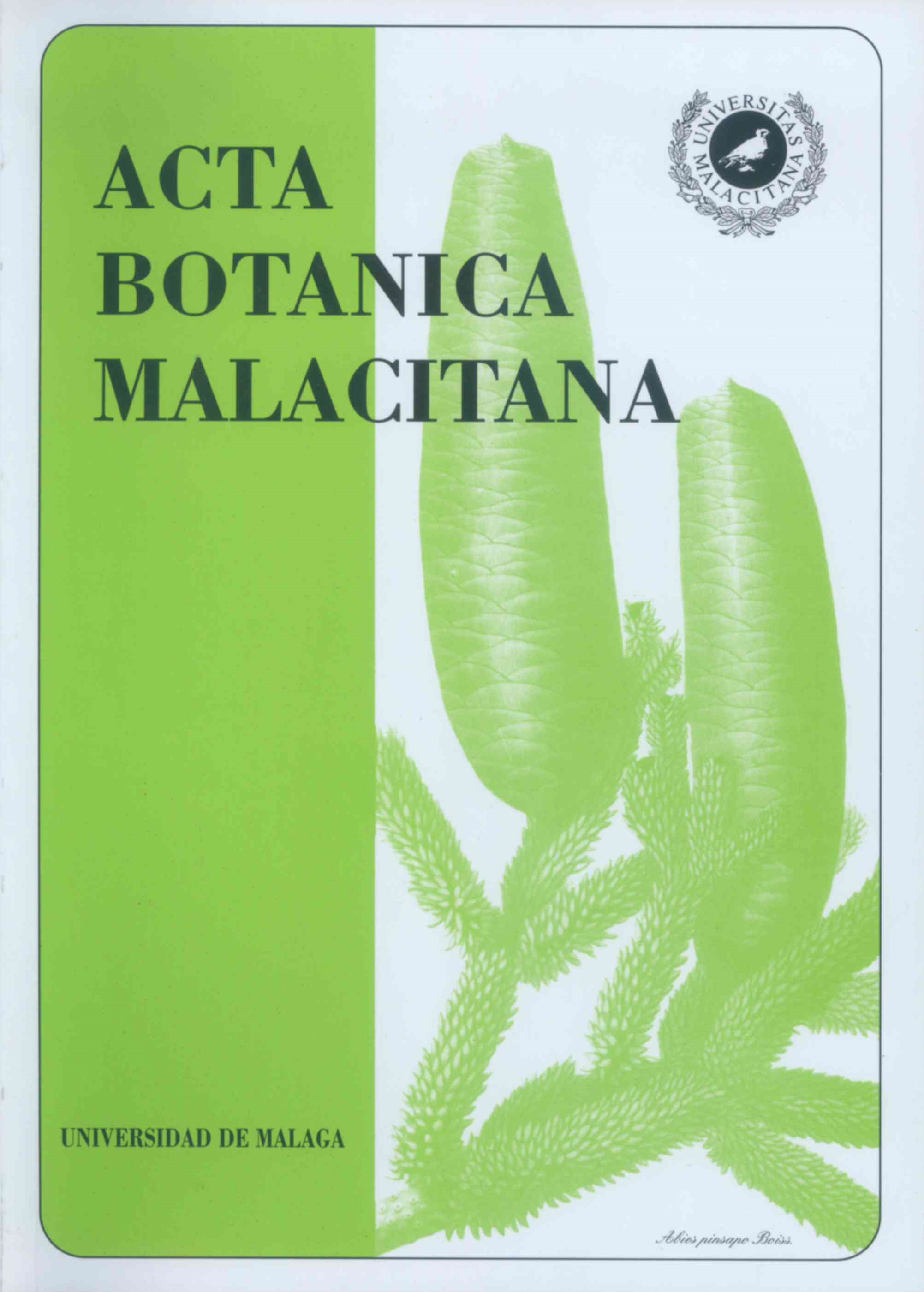Ecology and structure of Drosophyllum lusitanicum (L.) Link populations in the south- western of the Iberian Peninsula
DOI:
https://doi.org/10.24310/abm.v26i0.7378Palabras clave:
Brezales, Ericion umbellatae, Portugal, Serra de Monchique, España, fitosociología, endemismosResumen
Ecología y estructura de poblaciones de Drosophyllum lusitanicum (L.) Link en el suroeste de la Península Ibérica
Drosophyllum lusitanicum es una planta autógama y nautocórica cuyo tamaño y estructura de población han sido estudiados en dos áreas del suroeste de la Península Ibérica. Su carácter cenológico se documenta mediante una tabla fitosociológica sintética basada en inventarios ya publicados y datos nuevos. En la Sierra de Monchique (Portugal) se cartografían 21 poblaciones cuyo tamaño medio es de 165 individuos. Sin embargo, en el Campo de Gibraltar (España), se encontró la población de mayor tamaño, con varios miles de individuos en la Sierra del Aljibe. Aquí se estudió el tamaño de las plantas, el diámetro de la roseta basal y el grado de lignificación de 700 individuos, lo que se utilizó como indicador indirecto de la estructura de edades de 19 poblaciones. Drosophyllum lusitanicum tiene un cierto carácter pionero. Se presenta mayoritariamente en los brezales aclarados de Ericion umbellatae (Statiracantho-Drosophylletum, Querco lusitanicae- Stauracanthetum, Genisto tridentis-Stauracanthetum, cte.). Es capaz de colonizar medios alterados, como cunetas de carreteras y cortafuegos, y es un apófito en las comunidades basales de Drosophyllo- [Stauracanthenion], siendo además esta especie favorecida por los frecuentes incendios de la zona. En los alcornocales abiertos de Myrto-Quercetum suberis y en los brezales densos de Erica australis predominan los individuos grandes, siendo éstas poblaciones maduras. Finalmente, se aportan algunos datos poco conocidos de su reproducción y ecología que indican la necesidad de un mayor esfuerzo para la conservación del área portuguesa estudiada.
Descargas
Métricas
Citas
ARROYO, J. & T. MARAÑÓN -1990- Community ecology and distributional spectra of Mediterranean shrublands and heathlands in Southern Spain. J. Biogeography 17: 163-176.
ASENSI, A. y B. DÍEZ GARRETAS -1987- Andalucia occidental. In: Peinado Lorca M. & S. Rivas-Martínez (eds.) La Vegetacion de España: 197-230. Alcalá de Henares.
BARKHAM, J.P. -1980- Population dynamics of the wild daffodil (Narcissus pseudonarcissus). I. Clonal growth, seed reproduction, mortality and the effects of density. J. Eco! 68: 607-633.
BOESEW1NKEL, F. D. -1989- Ovule and seed development in Droseraceae. Acta Bot. Neerlandica 38: 295-311.
BRAUN-BLANQUET, J. -1964- P flanzensoziologie. G rund züge der Vegetationskunde. 3r". Edit., Berlin, Wien, New York.
BRAUN-BLANQUET, J., A.R. PINTO DA SILVA & A. ROZE1R A -1964- Resultats de trois excursions géobotaniques á travers le Portugal septentrional et moyen — Ill Landes á Cistes et Ericacées (Cisto-Lavanduletea et Calluno- Ulicetea). Agronomic, Lusitana 23: 229-313.
CHEERS, G. -1992- LetCs Guide to Carnivorous plants of the World. London.
DE1L, U. -1 997a- Zur geobotanischen Kennzeichnung von Kulturlandschaften. Erdwissenschaftliche Forschung Vol. 36. Stuttgart.
DEIL, U. -1997b- Distribution and ecology of some rare plant species in Northern Morocco I: Teucrium afrum ssp. rubri florum and Euphorbia transtagana. Acta Bot. Malacitana 22: 250-254.
DIERSCHKE, H. -1994- Pflanzensoziologie. Grundla gen uncí Methoden. Stuttgart.
GALÁN DE MERA, A., U. DEIL, J.A. VICENTE ORELLANA & I. SÁNCHEZ GARCÍA. -1996- Nothobartsia aspera (Scrophulariaceae): nuevas localidades, ecología y fitosociología. Acta Bot. Malacitana 21: 309-310.
GALÁN DE MERA, A. & J. A. VICENTE ORELLANA -1996- Phytosociological study of the plant communities with Stauracanthus boivinii of the SW of the Iberian Peninsula and NW of Africa, using multivariate analysis. Bol. He/v. 106: 45-56.
GARRIDO DÍAZ, B. y J. M. ORTIZ HERRERA - 1996- Introducción a la biología de Drosophyllum I usitanicum (L.) Link. Almoraima 15: 233-243.
GIL JIMÉNEZ, Y., P. NAVAS FERNÁNDEZ, D. NAVAS FERNÁNDEZ, A.V. PÉREZ LATORRE y J.M. NIETO CALDERA -1996- Tipos de habitats naturales contemplados en la directiva 92/43 C.E.E. presentes en el Campo de Gibraltar y espacios naturales de interés para su conservación. Almoraima 15: 255-266.
HOLDEREGGER, R. -1996- Reproduction of the rare monocarpic species Saxifraga mutata L. Dot. J. Linnean Society 122: 301-313.
HOLDEREGGER, R. -1997- Intrapopulational size structure of the monocarpic species Saxifraga mutata and its relationsship to succession. Flora 192: 151-156.
KOPECKY, K & S. HEJNY -1974- A new approach to the classification of anthropogenic plant communities. Vegetatio 29: 17-20.
KROHMER, J. & U. DEIL -1999- Landnutzungswandel in der Serra de Monchique (Stidportugal) in Abhangigkeit von nattirlichen und anthropogenen Bedingungen. Geoiikodynamik 20: 169-192.
MALATO BELIZ, J. -1982- A Serra de Monchique. Flora e VegetaÇiio. Colecgdo "Parques Naturais", Vol 10. ServiÇo Nacional de Parques, Reservas e Património Paisagístico. Lisboa.
NEZADAL, W., DEIL U. & W. WELSS -1994- Karte der aktuellen Vegetation des Campo de Gibraltar (Provinz Cadiz. Spanien). Hoppea, Denkschrift Regensb. Bol. Ges. 55: 717-756.
NIETO CALDERA, J.M, A.V. PÉREZ LATORRE y B. CABEZUDO -1990- Datos sobre la vegetación silicícola de Andalucía I. Acta Bot. Malacitana 15: 179-192.
OCAÑA, M. E., B. VALDÉS, E. MORENO SOCÍAS y R. PARRA -2000— Drosophyllum lusitanicum (L.) Link. In: G. Blanca et al. (eds.) Libro Rojo
de la Flora Silvestre Amenazada de Andalucia. Tomo II. Especies Vulnerables. Consejería de Medio Ambiente. junta de Andalucia. Sevilla.
OJEDA. F., ARROYO J. & T. MARAÑÓN -1995- Biodiversity components and conservation of Mediterranean heathlands in southern Spain. Biological Conservation 72: 61-72.
OJEDA, F., T. MARAÑÓN & J. ARROYO -1996a- Patterns of ecological, chorological and taxonomic diversity at both sides of the Strait of Gibraltar. J. Veg. Science 7: 63-72.
OJEDA, F., T. MARAÑÓN & J. ARROYO -1996b- Post fire regeneration of a Mediterranean Heathiand in Southern Spain. hit. J. Wild/and Fire 6: 191-198.
ORTEGA OLIVENCIA, A. O., J. P. CARRASCO CLA VER & J. A. DEVESA ALCARAZ -1995- Floral and reproductive biology of Drosophyllum lusitanicum (L.) Link (Droseraceae). Bol. J. Linnean Society 1 18: 331- 351.
PÉREZ LATORRE, AV., J.M. NIETO CALDERA y B. CABEZUDO -1993- Contribución al conocimiento de la vegetación de Andalucia II. Los Alcornocales. Acta Dot. Malacitana 18: 223-258.
PÉREZ LATORRE, AV., J. M. NIETO CALDERA y B. CA BEZUDO -1994- Datos sobre la vegetación de Andalucía Ill. Series de
vegetación caracterizadas por Quercus suber L.. Acta Bol. Malacitana 19: 169-183.
PÉREZ LATORRE, A. V., A. GALÁN DE MERA, U. DEIL y B. CABEZUDO -1996— Fitogeografía y vegetación del sector Aljíbico (Cádiz-Málaga,
España). Acta Bot. Malacitana 21: 241-267.
PÉREZ LATORRE. A.V., A. GALÁN DE MERA, P. NAVAS, D. NAVAS, Y. GIL y B. CABEZUDO -1999- Datos sobre la flora y vegetación del Parque Natural de los Alcornocales (Cádiz-Málaga, España). Acta Bot. Malacitana 24: 133-184.
QUÉZEL, P., M. BARBERO, A. BENABID, R. LOISEL & S. RIVAS-MARTÍNEZ -1988- Contribution a l'étude des groupements préforestiers et des matorrals rifains. — Ecologia Mediterranea 14: 79-122.
RIVAS-MARTÍNEZ, S. -1979- Brezales y jarales de Europa occidental (Revisión fitosociológica de las clases Calluno-Ulicetea y Cisto- Lavanduletea). Lazaron 1: 5-127.
RIVAS-MARTÍNEZ, S., M. LOUSA, T.E. DÍAZ, F. FERNÁNDEZ-GONZÁLEZ y J.C. COSTA - 1990- La vegetación del sur de Portugal (Sado, Alentejo y Algarve). Itinera Geobotanica 3: 5-126.
RUDNER, M., U. DEIL & A. GALÁN DE MERA - 1999- Zwergbinsengesellschaften im Südwesten der lberischen Halbinsel. Mitt. Bad. Landesver. Naturkunde u. Naturschutz NF., 17 (2) : 427-448.
SACHS, L. —1993- Statistische Methoden. Planung und Auswertung. T"• Ed.. Berlin.
SENG, M. & U. DEIL, -1999- Forest vegetation types in the Serra de Monchique (Portugal): Anthropic changes of Oak forests. Silva Lusitanica 7: 71-92.
SILVERTOWN, J., M. FRANCO, I. PISANTY & A. MENDOZA -1993- Comparative plant demography — relative importance of life-cycle
components to the finite rate of increase in woody and herbaceous perennials. J. Ecol. 81: 465-476.
VALDÉS, B. -1996- El elemento endémico en el Campo de Gibraltar. Almoraima 15: 13-33.
VALDÉS, B., S. TALAVERA & E. FERNANDEZ GALIANO (eds.) -1987- Flora Vascular de Andalucia Occidental. vol. 1411. Barcelona.
WERNER, P.A. & H. CASWELL -1977- Population growth and age versus stage-distribution models for teasel (Dipsacus sylvestris Huds.). Ecology 58: 1103-1111.
WILLIAMS, S.E., V.A. ALBERT & M.W. CHASE -1994- Relationships of Droseraceae: a cladistic analysis of rbc1 sequenced morphological data. Am. J. Bol 81: 1027-1037.
Descargas
Publicado
Cómo citar
Número
Sección
Licencia
Derechos de autor 2019 Acta Botanica Malacitana

Esta obra está bajo una licencia internacional Creative Commons Atribución-NoComercial-CompartirIgual 4.0.
Toda la información relacionada con la licencia de uso de los trabajos publicados en Acta Botanica Malacitana y con los derechos de autor se pueden consultar en nuestra Política Editorial.








1.png)


